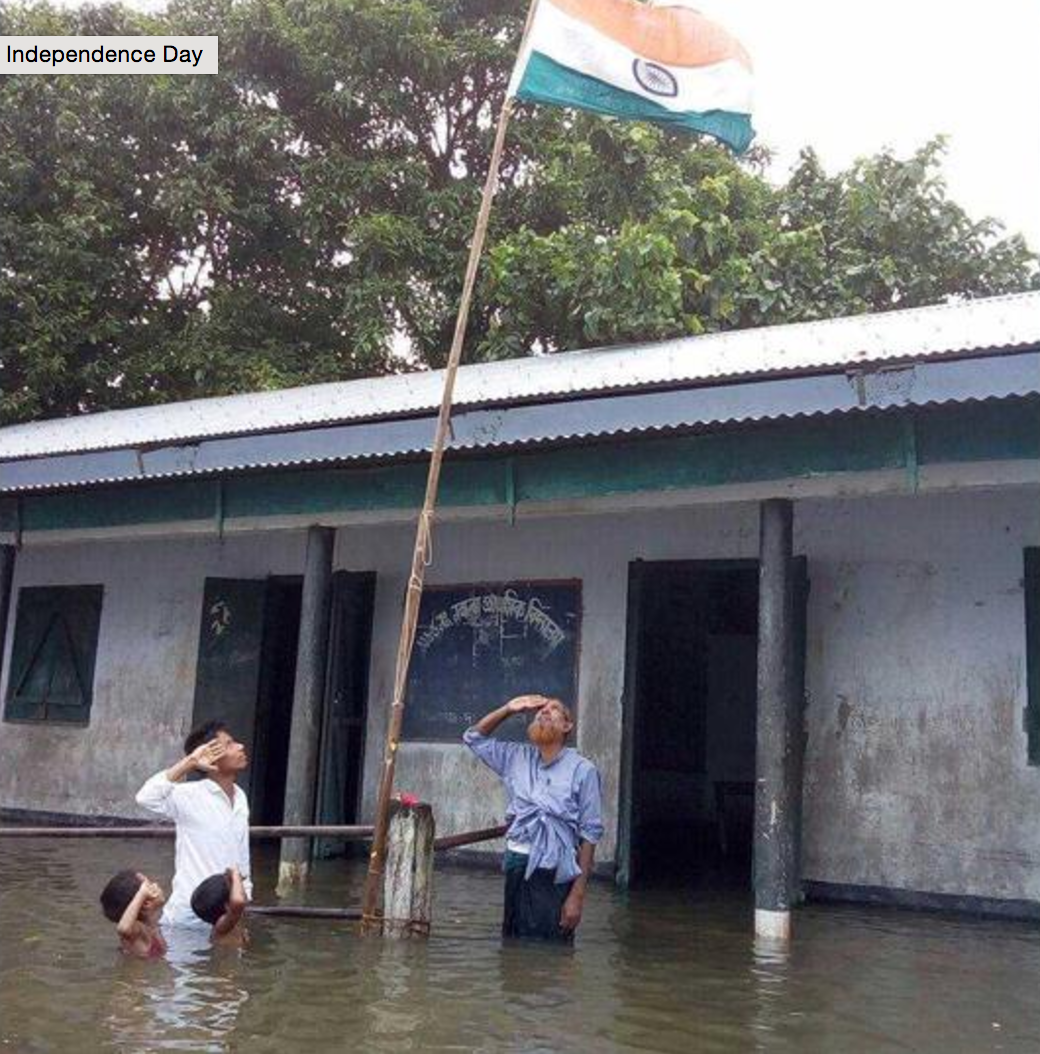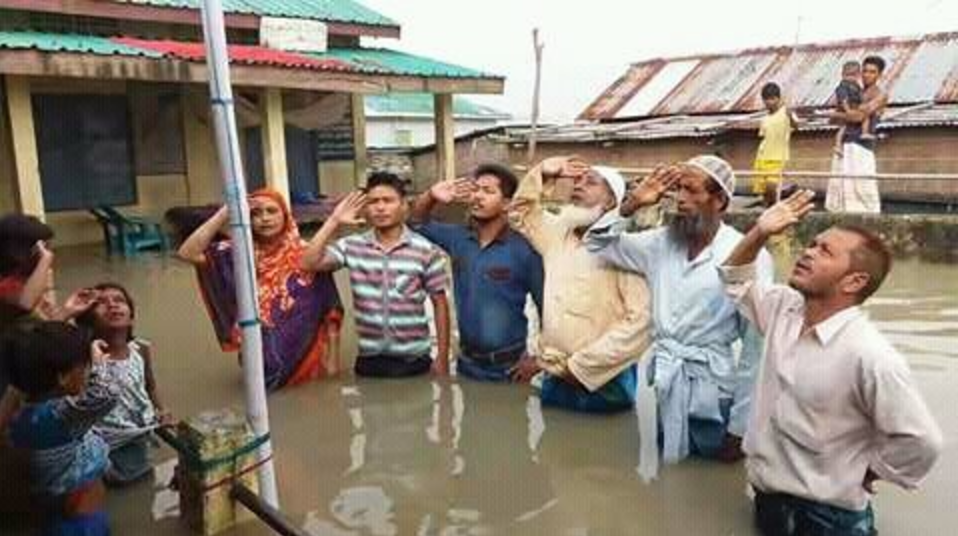

The image and the textual commentary that made its way around opened the ’emotional floodgates of nationalistic pride’, with many expressing deep admiration of the people photographed, their unabiding love for the nation being largely compared to the sacrifices of militarymen at border outposts. As ABP-News made no attempt at concealing, this image was particularly affective because
a.) it featured Muslims, and
b.) the blackboard at the background mentioned a school address which did not read in Hindi.
The imperial projection of the Hindu-nation was therefore complete: its tentacles espousing unflinching respect had spread beyond the periphery of the Hindi-speaking belt, and had deeply ingrained itself within the Indian-Muslim community even in its furthest crevices. The rabble-rousing minority community was now fully co-opted, managed and cleverly placed within a majoritarian discourse that respected the national flag even under dire circumstances.
Rehman’s image automatically drew comparisons with the French semiotician, Roland Barthes’ encounter with a magazine cover which he mentions in his book Mythologies. [1]

Visiting the barbershop one day, Barthes came across a French magazine Paris Match, which on its cover had the picture of a ‘young Negro in a French uniform saluting with his eyes uplifted, probably fixed on the fold of the tricolor’.[ii] Barthes argued that at the preliminary level of meaning-making, the image conveyed a simple literal message only – a soldier, an uniform, a raised arm, eyes lifted, a French flag. However, on further digging, he asserted that, the image revealed a lot more. The sign, the boy, the flag, the gestures in the first level merely became signifiers in the second level of signification: they carried another, a higher order of truth within them. Such a step-by-step analysis, Barthes insisted, provoked him, and possibly the reader alike to ask as to “What was Paris Match telling us, by using this picture of a black soldier saluting a French flag?”[iii] Barthes averred that one such plausible meaning would be that the magazine wanted to convey the greatness of the French empire, and ‘that all her sons, without any colour discrimination’ faithfully served under her flag.[iv] Moreover, ‘there was no better answer to her detractors of an alleged colonialism than the zeal shown by this Negro in serving his so-called oppressors’.[v] Barthes’ line harrowingly echoed the nationalist celebration of Rehman’s image – the detractors who alleged cultural colonialism by an overbearing Hindu nation upon a defiant muslim community had to now acclimatize themselves with the image of Muslims voluntarily saluting the flag, their zeal calibrated to the eternally rising flood-water levels.
Barthes felt that with the heady concoction of militariness, French-ness and racial anxiety, the image itself had, in fact, become a myth: a seemingly benign sign drawn to convey a larger truth, a medley of smaller signs that cumulated into a larger, more abstract one, a cascading series of meanings where the final brew could appear only as ‘natural, stilled and timeless in time, both distant and auratic, and simple and self-explanatory.’[vi] Aiding this myth-making process was the textual commentary itself – the Paris Match issue spoke nothing of France’s colonial ambitions, just as Rehman’s original text was forgotten in the midst of social media circulation, his identity and his plea for help getting lost amidst the countless “Vande Mataram, Jai Hind” texts that now accompanied the image. Even as the text drew parasitically upon the image, it nevertheless rationalized the image in the given context of a hectoring nationalist aspiration, sublimating it as something entirely detached from Rehman’s original post, a desperate call for help to these humane individuals. Now rationalized to convey a ultra-national political ethos, the photograph nevertheless was forced to weigh in on its sensory reality. While one could readily see, feel and experience the salute as a credible, well recognized gesture, one also had to negotiate the dilapidated building, the waters, and the flag hastily tied to a bent bamboo pole in its material reality. However at the same time, the image became ‘tamed’, ‘transparent’ and docile.[vii] The history of the image was either forgotten in due course of circulation or perhaps mildly remembered to highlight that Independence Day is a celebrated reality even in the worst flood-affected regions of the country. Here meaning was tapped only to resurrect a nation’s ethos, but swiftly dismissed to elide the ‘what, how and why’ of the image and the people involved. Therefore, when news started pouring in about the image a couple of days later, these media reports specifically engaged in a myth busting activity, tracing the origins of the image, and the contexts around which they might have come around in the first place. The journalists reported that one of the reasons why this photo was taken was because, it had to be sent to first to Amir Hamza at the cluster-resource co-ordination centre in Dhubri, who would then forward it to the block officer, and who in turn would send it to the education department, so on and so forth. All of this was in fact a response to an MHRD circular dated 7th August which ‘instructed’ schools to organize a set of programmes around Independence Day, asking students and teachers alike to promise to rid India of ‘corruption, terrorism, communalism and casteism by 2022’, and also document, share, upload and promote the same on social media.

A Huffington Post article claimed that by the headmaster’s admission, two children who knew how to swim were only chosen to stand near the hoisted flag, while the other kids stood at a distance of 10 metres from the flag, singing the national anthem. “We hoisted the flag, sang Jana Gana Mana and Vande Mataram while the rest of the students followed us from the road. In my 22 years of service, this is the first time we faced flood on Independence Day,” the headmaster informed the paper. While Rehman’s original motivation could not be known for certain, questions about why it was at all mandatory for schools to record Independence Day celebrations in a state reeling under heavy floods came to the forefront. More so for Dhubri, which is not only one of the worst-hit districts in Assam, with nearly 9 lakh people affected, but also a district with a majoritarian Muslim population. Soon after, the internet was also rife with this expose, expressing pleasure, sadness and anger in equal measure at this piercing of nationalist pride, illuminating the real reasons that lay behind the image.

While the image began to circulate as a discourse-generating object, it increasingly found itself playing a game of hide-and-seek, between a history that established too much of itself in the image, and a history that had to be obliterated for the myth (of the nation, of the photo) to sustain itself. And yet, as Barthes continued to hover around my experience/encounter with the image, one also re-realized that the actual site of myth-making about the nation was not necessarily only in the History textbooks that erased the Mughals, or the Aurangzeb Road that had to be re-named as Dr. APJ Abdul Kalam Road. The actual site of the murky nationalist fervor, the writing of myth-as-history, lies in the thousands of hate-speech clips, small churnings of fears, doctored clips, magazine covers or even ordinary images like the one here which can easily travel, gather momentum of their own, shape-shift as the need be. Nationalism lay, in fact, in the quite ordinary. As Barthes wrote elsewhere, “within each sleeps that monster, the stereotype, which is itself a repetition” of all that precedes it.
A myth is something therefore that pleads for repetition, returning each time to fulfill its presumed destiny with a ritualistic obsession, like an always unfinished GIF that performs its cycle of incompleteness time and again. There is no nationalism without its symbols (beef or beef ban, national flag, anthem, Hindu vs. Muslim social law, caste system, language, gender, occupations etc.) but there is no nationalism without a ritualistic repetition of symbols either. Hence the perpetual need to share and validate, the perpetual need to devise, develop and pass various patriotic tests, the perpetual need to answer shrill calls of endurance and sacrifice. The waters are rising, and like the kids in Rehman’s image, the marginalized find themselves dangerously close to being washed away.
[1] Roland Barthes, Mythologies, trans. Annette Lavers (New York: The Noonday Press, 1972), 115.
[ii] Ibid.
[iii] Stuart Hall, Representation: Cultural Presentations and Signifying Practices (London, Thousand Oaks, New Delhi: Sage Publications, 1997), 39.
[iv] Barthes, op cit.
[v] Ibid.
[vi] Ibid, 111-115.
[vii] Ibid, 118.
Courtesy: raiot.in
